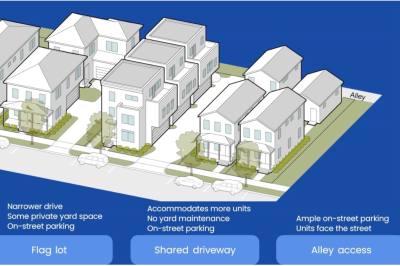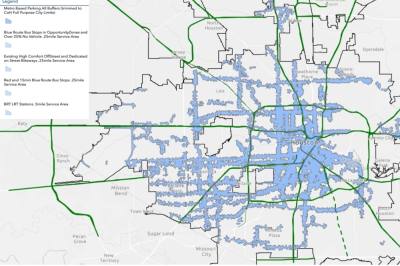These recommended revisions to the city's code of ordinances align with previously approved city plans, such as the 2020 Climate Action Plan, by working toward the improvement of sidewalk connectivity and removal of barriers to allow for multimodal transportation.
Suvidha Bandi, a project manager with the planning and development department, presented proposed changes at a virtual April 18 public meeting, one of several meetings hosted by the city in April. The presentation also included an overview of the goals of the proposals from Aracely Rodriguez, city planner with the planning and development department.
“We know that the population has been increasing the development happening all over the city,” Rodriguez said at the April 18 meeting. “We need to create a tool to create more accessible, diverse neighborhoods with access to greater transportation options and with more attainable housing option for all Houstonians.”
More midlevel housing options
It was noted by Rodriguez that the city of Houston has ample stock of detached single-family homes and midrise apartments but lacks the housing options in between, known among city planners as the “missing middle housing.”
The changes being proposed won't override pre-existing deed restrictions, Bandi said.
Bandi noted four main types of midlevel housing, which the proposed amendments would allow for more of: second dwelling units, multiunit residential, courtyard-style developments and narrow lot developments.
A second dwelling unit—also known as an accessory dwelling unit, or ADU—is a second living space located on the lot of a single-family home, usually above a garage or in a separate structure. The Livable Places committee is proposing to eliminate the size limit for ADUs on lots without deed restrictions and allow parking for this type of housing to be based on unit size.
Under this plan, if the first unit has two off‐street parking spaces, then zero parking spaces would be required if the second unit is less than 1,000 square feet; one off-street parking space would be required if the second unit is between 1,000-1,500 square feet; and two off-street parking spaces would be required if the second unit is larger than 1,500 square feet.
Multiunit residential housing includes triplexes, multiple duplexes, fourplexes and multiplexes with up to eight units. Livable Places's goal is for this type of housing to be three to eight units maximum with buildings being no more than two to three stories with a total height of 30 feet as well as parking located on the rear or side of the property.
One parking space would be required per unit for units less than or equal to 1,500 square feet, regardless of how many bedrooms a unit has; two parking spaces would be required for units greater than 1,500 square feet; one guest parking space would be required per every six units; and one bike parking space would be required if the property is located in a market-based parking area.
Courtyard-style developments are clusters of single-family homes located around a shared courtyard with shared parking. Livable Places is seeking to change the city code to allow lots to front on common courtyard space, eliminate minimum lot size requirements and allow the parking to be decoupled from the lots to be potentially rented by residents.
Proposals for narrow lot developments deal with how lots are split into smaller lots with less than 40 feet of road frontage or a shared driveway. It is common for these lots to feature adjacent front-facing lots with combined driveways or two driveways adjacent to each other on the same lot, Bandi said. This makes for less available street parking and can mitigate sidewalk connectivity, she said.
Bandi instead noted three other types of narrow lot development that Livable Places is advocating to be incorporated into future development in the city: flag lots, shared driveways and the utilization of alley access.
A flag lot would entail one home in the back of the lot and the other in the front, sharing a driveway, with the latter home directly abutting the street. A shared driveway between multiple homes is another recommendation to decrease curb cutoffs and allow for more street parking.
Lastly, Livable Places is asking for alley access to be used if the lot has an alley. With this plan, there would be one parking space per unit of 1,500 square feet or less and two parking spaces for units larger than 1,500 square feet.
Market-based parking near transit
To meet outlined steps in plans such as the Climate Action Plan, the Livable Places committee is recommending lowering the parking requirement to allow for “context-sensitive rules,” Bandi said.
Any area within a half-mile of transit; rail stations; high‐frequency bus stops; transit stations; park and rides; Blue Route stops within opportunity zones; or within a quarter-mile of high‐comfort bike paths, trails and BCycle stations would become known as market-based parking zones and would be subject to lower thresholds for parking needs.
“This will provide alternatives for those that are in [the] growing demographic in Houston of one-car and no-car households, either by choice or by necessity,” Bandi said.
What's next
Livable Places is taking feedback from the public on these recommendations until April 27, at which point the draft will be presented to the Houston Planning Commission.







